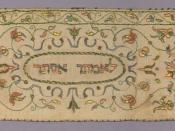Judaism's sacred texts extends far beyond their religious significance. These sacred texts carry a variety of meanings from a moral, spiritual and practice guide to everyday life. These sacred text being Torah, Tanakh, Mishnah, Talmud, Nevi'im and Ketuvim help convey the message of Judaism that was sent to Abraham.
The Torah originated in about 1400 BCE and the legal and ethnical codes of the Torah can be studied as including the 613 commandments and which also include the Ten Commandments. The first five books of the Bible include the Genesis, Exodus, Leviticus, Numbers, Deuteronomy. The 613 commandments were revealed to Abraham and his descendents, the Exodus from Egypt, at Mt. Sinai which gave commands to help the Israelites out of Egypt and into the Promised Land. The principal message of the Torah is the absolute unity of God, His creation of the world and His concern for it and His everlasting covenant with the people of Israel.
As the importance of the Torah being 'of everyday life of the believers is evidenced in the customary placement of the mezuzah on the doorpost of Jewish homes.' The use of the Torah 'is divided into fifty-four "portions," which are read at the synagogue every Sabbath in an annual cycle, beginning and ending shortly after the Jewish New Year.' Jewish thinking in tradition is to live by the Torah is to live as a religious Jew.
The Tanakh is all the three sacred books combined such as the Torah, Nevi'im and Ketuvim. The Jewish Bible is known as the Tanakh and which is the Jewish principle. 'The Jewish canon is distinguished from the Christian canon in the non-inclusion of the New Testament and a slightly different order of presentation of the Prophets.' The books of the Prophets include historical writings covering the period...


